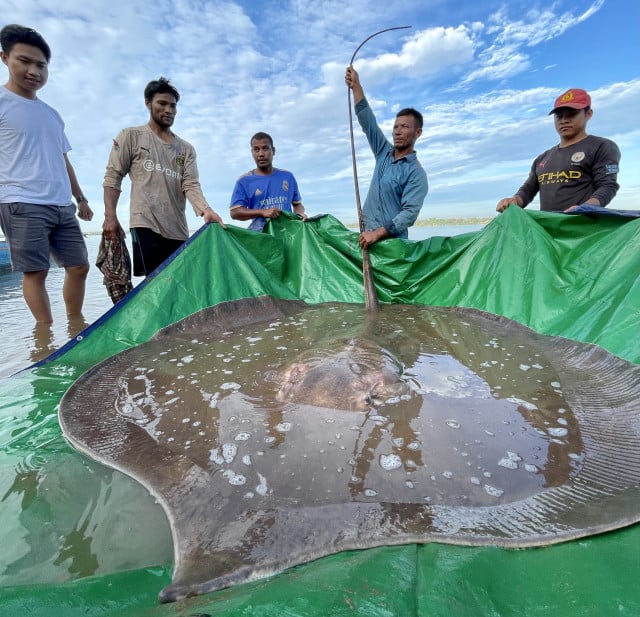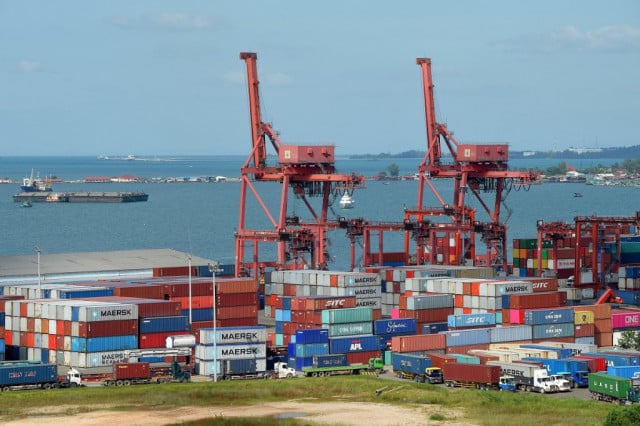Rare Giant Stingray Found in Mekong Deep Pools

- By Sao Phal Niseiy
- May 11, 2022 2:47 PM
Remote area home to endangered species
PHNOM PENH – A massive endangered giant freshwater stingray weighing 181 kilos has been caught in the deepest area of the Mekong River, USAID-funded project Wonders of Mekong says.
Zeb Hogan, University of Nevada fish biologist and project lead of the Wonders of Mekong, said the 3.9-meter female fish was rescued in cooperation between his team and local fishermen.
It was captured accidentally when it swallowed a smaller fish that had taken a baited hook and was released after being weighed and measured.
Interviews with fishers in the region suggested that the stingray was dwarfed by others perhaps twice as big caught in the same remote area over the past 20 years.
“The fishers here tell stories of catching record-breaking stingrays and other giant fish,” Hogan said.
The catch, together with other data collected by a recent scientific expedition to the area, suggests that the site – which is characterized by pools up to 80 meters deep and is an essential habitat for such iconic animals like Irrawaddy dolphins and giant softshell turtles – could also be home to the world's largest freshwater fish.
“It's a true wonder that a place like this still exists,” Hogan said.
The stingray and its habitat highlight characteristics of the Mekong's aquatic ecosystems generally: diverse, globally significant, poorly understood and under threat.
"They are unseen worlds, underappreciated and out of sight,” he said.
The giant freshwater stingray is one of Southeast Asia’s largest and rarest fish, and the study of the fish was the focus of a recent Wonders of Mekong’s project expedition to Stung Treng province.
Despite its size and threatened status, the giant freshwater stingray is an understudied species.
“A major reason why scientists know so little about it is because the fish inhabits remote, murky waters,” Hogan said.
“They’re not considered a good food fish in Southeast Asia, so they’re rarely targeted by fishers, though they occasionally get caught accidentally, as in the case of this ray.”
Hogan added that while it packs a poisonous, serrated stinger up to 38cm (15 inches) long, it’s typically a non-aggressive, inquisitive creature.
He first saw a giant freshwater stingray in the Mekong River in Cambodia more than 20 years ago in his research.
New threats to the river’s biodiversity
The discovery of the stingray was made during the first deep pool expedition conducted by the Wonders of Mekong team.
The study area is just downstream of a Ramsar wetland of international importance, which is home to many of the Mekong's almost 1,000 fish species.
These include most of the Mekong's imperiled giants – like the giant stingray, Mekong giant catfish and giant barb – all of which may grow up to 270 kilos and three meters.
In the deep pool expedition, the team was able to capture on video schools of migratory catfish 80 meters below the surface. It discovered migratory fish known as trey chhwiet in Cambodia.
The fish used to migrate over the nearby Khone Falls in April and May and formed the basis of a communal fishery on Don Sadam Island before the construction of the Don Sahong Dam near the Lao-Cambodia border in 2020.
It also found Helicophagus waandersii which is known as the mouse-faced fish because of its long whiskered snout.
However, the underwater records also exposed many issues affecting the biodiverse rare fish. One of them is rampant plastic waste found even in the deepest stretches of the Mekong River, along with “ghost nets,” abandoned fishing nets which continue to trap fish.
In March, the United Nations' Convention on the Conservation of Migratory Species of Wild Animals warned that plastic pollution has threatened migratory species in the Mekong and Ganges rivers in its new report.
Mekong and the Ganges rivers together contribute an estimated 200,000 tonnes of plastic pollution to the Indian and Pacific oceans every year.
Titled “Risk assessment of plastic pollution to migratory species in the Mekong and Ganga River Basins” the report was launched during the fifth session of the United Nations Environment Assembly in Nairobi, Kenya.
The report highlights that the critically endangered Mekong catfish and the Mekong River subpopulation of the Irrawaddy dolphin face lethal threats from entanglement and ingestion of plastic.
“Drowning because of entanglement in nets is the key threat to Irrawaddy dolphins that are estimated to number less than 100 individuals. It is long-lived, matures late, and is a long-distance migrant,” the report read, adding that this makes it even more vulnerable to human disturbances such as plastics and dams.
The statement highlighted plans to build several dams in Cambodia’s portion of the river, which conservationists say will have devastating ecological effects and could seriously threaten local food security in an area already affected by climate change.
Sudeep Chandra, limnologist at the University of Nevada, Reno who has studied the world's largest and deepest lakes, also shared the concern over the future ecological wellbeing of the river.
“The accelerating pace of development and dam-building, coupled with cumulative impacts of transboundary stressors and the impending impacts of climate change, point to a common concern among those who work and live in the lower Mekong River Basin: a fear that the river, which is the lifeblood of most of Southeast Asia, will gradually become so fragmented it will lose function, and thus no longer support the huge diversity of wildlife and millions of people that depend on it,” said Chandra, who is also the director of the University of Nevada, Reno's Global Water Center.
Mekong fish provide around 76 percent of protein consumed in Cambodia, and the Mekong countries have long been tapping their natural resources for economic growth and have constructed many dams for hydropower and other purposes.
Hogan called for more action to protect rare species. “We must act now before species like the giant freshwater stingray are gone forever,” Hogan said.
"The existence of these places – like the unseen world of the Mekong's deep pools and the animals that live there – are a true underwater wonder that warrants our attention, care, and protection.”















